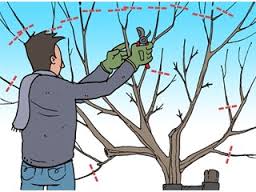 I am a pruning anarchist. Without pruning guide in hand, I use some common sense. And a pruner. I prune between September and March, when I have time and feel for it. And if it does not freeze. On a beautiful sunny winter or spring day. Often in February. I do not prune any tree or shrub every year. But if I prune I cut quite a bit off. So I am trying to get a beautiful, open form where light can get in. And where I can easily put a ladder and can reap.
I am a pruning anarchist. Without pruning guide in hand, I use some common sense. And a pruner. I prune between September and March, when I have time and feel for it. And if it does not freeze. On a beautiful sunny winter or spring day. Often in February. I do not prune any tree or shrub every year. But if I prune I cut quite a bit off. So I am trying to get a beautiful, open form where light can get in. And where I can easily put a ladder and can reap.
Old and dead wood goes out. Branches that cross over each other or are sanding, or grow out of range, or too close together: away. Long, shooting suckers or long twig: heavy shorten or flipping. And then I let nature take its course. Who knows better than I what to do.
About how it really should be often exist as many views as there are pruners.
Pruning makes growing. At the wound edges new shoots will arise back. Most of them you cut off again. (Also in the summer.) After a heavy pruning you’ll have less fruit next season. But then again just more.
Low stemmed are pruned annually. Standard and mediate get the first years topiary, and after the fifth year: every 2-3 years maintenance pruning.
A crown needs air and light. Sun lets ripen fruits. Sun and wind dry the wet leaves quickly so mold spores are less likely to develop.
Heavy pruning (with the (chain)saw)) gives the risk that the tree will break, die through all that growth stimuli. So work with a long-term plan in stages to achieve serious action.
Also with a haggard, old hedge that was much too wide you'd better just shorten one side. The following year, e.g. the top, and a year later the other side. Even with a drastic pruning session you may never remove more than max. 20%.
Plants and their growth are matched with the seasons and the sunlight they need. The greatest vigor they have during the lengthening days of spring. After the summer solstice (June 24, St. John) grow slows down. St. John shoots are late offshoots of a tree, after that date. Hedges and shrubs should be pruned after that date less than normal.
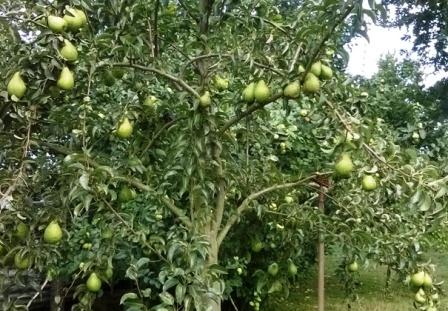 Apple and pear trees are regularly pruned.
Apple and pear trees are regularly pruned.
The fruits are mainly on short shoots, short knobby twigs.
Long shoots are infertile smooth and straight twigs washing especially abundant in the first years of growth. So many short shoots provide lots and small fruit. To get more fruits you can thin short shoots in the spring. A fast-growing tree makes little flower buds. A richly flowering and fruit-bearing tree (with many short shoots) grows little.
Most fruits grow on year-old wood, not on old wood. The fruit in pear wood has a longer life. In 'Conference' to 2 years old. Pear trees are late fertile.
Annual twigs you let stand, or prune them at the base, completely. Half shortening makes little sense. You then just cut off all potential buds. You'll get a lot of shoots, but no fruit.
Vertical branches grow and flower little. With horizontal branches it is just reversed. So you get more blossoms and fruits by bending annuals branches horizontally so that they bloom next year. You see this often in plantations that branches are tied down with a rope to the trunk. Whether there are concrete weights, or plastic bottles with water hung on. Later on, the weight of the fruits will keep the arms horizontal.
Low stemmed pears grow fast and strong. As a growth inhibitor is root pruning done (roots stabbing with a spade). Or every 2 to 4 years cutting in (about 2 weeks before flowering). Often on 1 or 2 places the stem is even sawed in half. That would provide more fruit. Personally I think that this is more a panic- and survival reaction of the tree which gives more fruit. But of cours then, in the production that is what it’s all about.
Stone fruit (plum, sweet cherry, sour cherry, peach, apricot) are much less pruned. Do it before or after flowering, or immediately after (and during) the harvest. The wounds may heal then a bit for the winter, which reduces the chance of galena attack.
Peach needs a lot of warmth and shelter from frost and rain, such as on a south wall. It is early flowering (March - April). To get fruit set is insect pollination needed. It is seldom that period in our climate. Manual pollination is the solution.
In 1977 the oldest peach pit in the Netherlands was found at the Roman fleet base in Velsen: 2000 years. At Kunming in southwest China, eight fossilized peach seeds were found that were at least 2.5 million years old. The peach may therefore be older than humans.
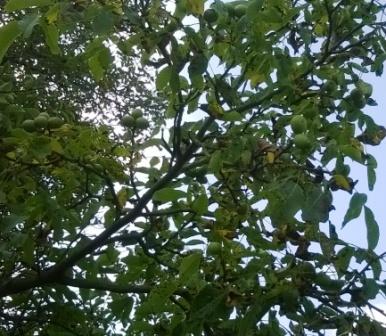 Nut trees are rarely pruned. Previously nuts were clubbed, throwing a stick or hit the nuts off. That suffices as pruning. Only a topiary in the juvenile phase in late March to mid-April is helpful.
Nut trees are rarely pruned. Previously nuts were clubbed, throwing a stick or hit the nuts off. That suffices as pruning. Only a topiary in the juvenile phase in late March to mid-April is helpful.
Fruit trees, depending on species, rootstock, location etc. are 30 to 100 years old.
When do trees start bearing fruit?
Depending on the species, the age of the seedlings and planting and growing conditions it will take 2 to 4 years. The seedlings will be 5 to 8 years. At a low stem plum tree I've had fruit already in the first year.
If you plant a pip, and let it become an apple tree, it will take about 8 years for before he has fruits. This is only done to develop new material. In practice, our trees are grafted. Grafted trees are species specific with a certain harvest, and earlier fertile (wear from the third year).
Pears are slower. It takes four to five years before the first pears appeare. Production in the first years is also lower than in apples. But lifetime is much higher: up to 50 years and more.
A walnut tree bears fruit from the tenth year. Hazel idem (except grafted shrubs).
Chestnut usually has after five years (or more) fruits. But he also goes on for the ages.
Pruning bushes
Medlar tree
Prune from November to late March each five years thickest branches above young branchings close to their base.
Filbert / hazel
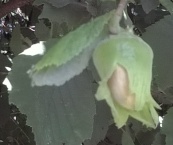 The male flowers are in catkins and are already in the summer formed in the axils of the leaves, but thrive until January. The female flowers are by three to four in a small button at each other. Pruning from February to late March. Cut the largest branches that bear no fruit every five years away. Keep on each bush ten fast growing and productive branches. Remove the suckers (almost vertical branches) in the middle of the bush. Remove crossing and weak branches at the base of the plant.
The male flowers are in catkins and are already in the summer formed in the axils of the leaves, but thrive until January. The female flowers are by three to four in a small button at each other. Pruning from February to late March. Cut the largest branches that bear no fruit every five years away. Keep on each bush ten fast growing and productive branches. Remove the suckers (almost vertical branches) in the middle of the bush. Remove crossing and weak branches at the base of the plant.
Red and black currant
Cut each year the oldest branches just above the ground so that a dozen fruit-bearing branches remain. Select at the base of the plant some fast growing branches that will replace the removed branches within 1 or 2 years, and shorten them half.
Raspberries
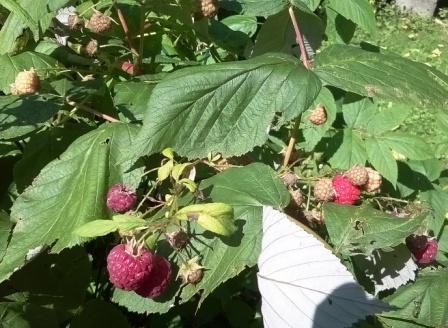 Summer bearing bush: cut each year in July (after harvest) the branches that have borne fruit just above the ground.
Summer bearing bush: cut each year in July (after harvest) the branches that have borne fruit just above the ground.
Fall bearing bush: in September (after the second harvest) flip the dry branches that have borne fruit.
Black berry, bram bush
Cut the end of February - beginning of March the branches that have borne fruit just above the ground.
Blue berries
Preserve to 5 main branches that are not curtailed the first two years. From the third year regular replacement pruning of worn shoots.
Gooseberry bush
Pruning in February, the oldest (least productive) branches near the ground. Also remove weak, dead, tangled and low branches.
Grapes
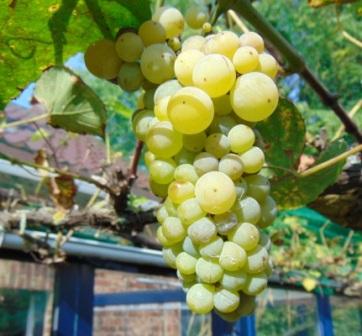 Prune grapes during their rest period from November to February. Later, the plant will 'bleed ' (loss of moisture) very much. You never cut too much off.
Prune grapes during their rest period from November to February. Later, the plant will 'bleed ' (loss of moisture) very much. You never cut too much off.
Don’t touch the grapes when pruning (or cluster thinning: remove small and weak grapes), because that will damage their protective wax coating. Want a cluster to keep for longer, harvest then with a two-sided piece of branch. Place the longest piece (strain side) in water (more than 2 months!) to keep the fruit longer fresh. You can put them as flowers in a vase.
Still unripe bunches that break or (accidentally) are pruned you can use to make verjus.
Sweet Sapphire and Moon Drops are commercial names of special and tasty, very long, black and seedless grapes (Vitis vinifera).
Pruning tools
There are two types of pruning shears (hand clippers).
At the secateurs called bypass shears the blade as in a pair of scissors cuts amongst the other cheek. This provides a smooth cut, and is suitable for green wood.
At the anvil system the blade presses vigorously through the wood against the flat anvil. This is more suitable for dead wood.
If the handles are long (+50 cm), we call it a lopper. Thus you can cut branches up to at least 4 cm. Often the arms can be enlarged, so you also get a greater range.
With a hedge trimmer that has two large blades and has two handles, you can also cut e.g. lavender and heather beside hedges.
Telescopic or extendable pole pruner is usually operated with a pull rope. Usually you can also replace the (somewhat oblique or transverse) shears by a saw.
(Brief info about fruit diseases: fungi and viruses infestations can be found e.g. here :)
http://www.caf.wvu.edu/kearneysville/wvufarm8.html
